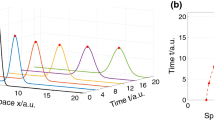Abstract
The definitions of the temperature resolution, the so-called resolution of DSC instruments given in literature are discussed. A new definition of the resolution for DSC instruments is presented and outlined. The main characteristic introduced in this new definition is a minimum between two caloric events as a prerequisite of an existing resolution. Possible candidates of test substances have been evaluated. The oligomer n-hexatriacontane is revealing an interesting phenomenon, namely a lambda transition which is in the peak temperature only 2 K lower than the melting temperature of 76°C. The substance was selected as an ideal test substance for the quantification of the resolution of DSC instruments. The lambda transition is a second order process which may reach under certain conditions the saturation of the occurring molecular dislocation within 0.2 K, and after saturation the heat flow rate drops sharply down. Investigations concerning the main characteristics of n-hexatriacontane in respect to the temperatures of transition (lambda transition and melting), to the involved enthalpies, and to the resolution factors were performed as functions of the sample mass and the heating rate. The importance of relevant evaluation procedures increasing the resolution factors of DSC curves are discussed and these procedures are integrated into the testing of the resolution. The necessity for widening the experimental scope from instruments to evaluation procedures is forced by the existence of instruments with built-in signal treatments based on electronic devices and software procedures. A comparison with literature data is outlined for all of the mentioned characteristic values of n-hexatriacontane.
Similar content being viewed by others
References
E. Marti, E. Kaisersberger, G. Kaiser and W.-Y. Ma, Netzsch Annual 2000 'Thermoanalytical Characterization of Pharmaceuticals' Netzsch-Gerätebau GmbH, D-95100 Selb/Bavaria.
P. J. van Ekeren, C. M. Holl and A. J. Witteveen, J. Thermal Anal., 49 (1997) 1105.
G. W. H. Höhne, W. F. Hemminger and H.-J. Flammersheim, Differential Scanning Calorimetry, 2nd ed., Springer, Berlin 2003, p. 250.
Sigma-Aldrich, Product Description (www.sigmaaldrich.com).
A. Bauer-Brandl, E. Marti, A. Geoffroy, A. Poso, J. Suurkuusk, E. Wappler and K. H. Bauer, J. Therm. Anal. Cal. 57 (1999) 7.
E. S. Domalski and E. D. Hearing, J. Phys. Chem. Ref. Data, (1990) 881.
E. S. Domalski and E. D. Hearing, J. Phys. Chem. Ref. Data, 1 (1996).
A. A. Schaerer, C. J. Busso, A. E. Smith and L. B. Skinner, J. Am. Chem. Soc., 77 (1955) 2017.
H. A. Stuart, Die Physik der Hochpolymeren, Bd. III, Springer, Berlin 1955, p. 450.
O. T. Srensen and J. Rouquerol, Sample Controlled Thermal Analysis, Vol. 3 Series Ed., J. Simon, Kluwer Academic Publishers, Dordrecht, The Netherlands 2004.
G. W. H. Höhne und W. Kunze, Laborpraxis, Dezember 2001, 38.
Author information
Authors and Affiliations
Rights and permissions
About this article
Cite this article
Marti, E., Kaisersberger, E. & Emmerich, WD. New aspects of thermal analysis, Part I. Resolution of DSC and means for its optimization. Journal of Thermal Analysis and Calorimetry 77, 905–934 (2004). https://doi.org/10.1023/B:JTAN.0000041669.06816.36
Issue Date:
DOI: https://doi.org/10.1023/B:JTAN.0000041669.06816.36




